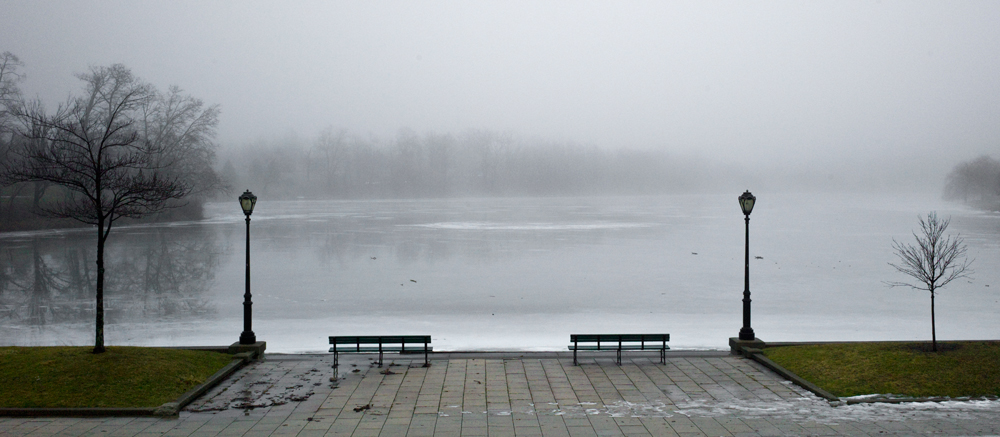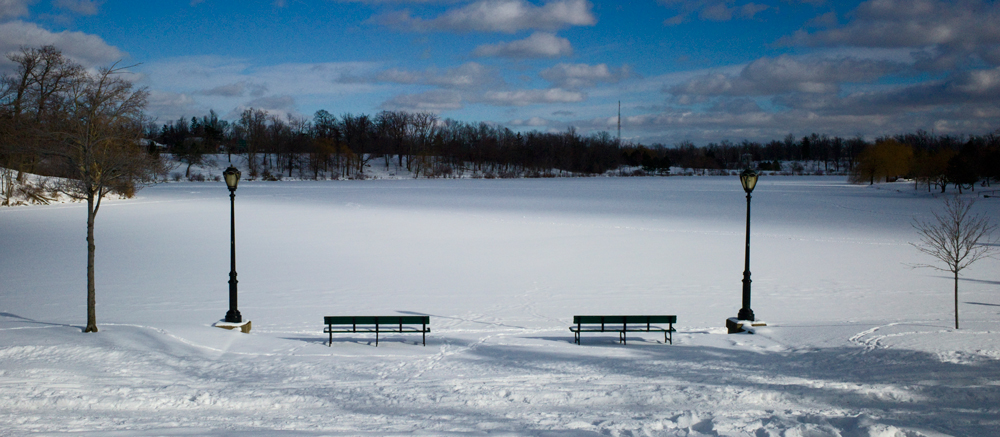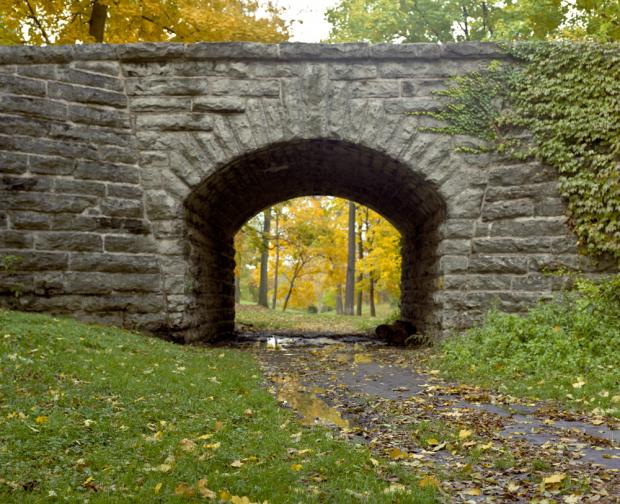Undoing Olmsted
The joint in Delaware Park
This is about the current plan to put a privately operated restaurant/bar in the casino in Delaware Park, a plan delivered to the Buffalo community by the Olmsted Conservancy—which has a contract with the city to maintain the Olmsted Parks. The only justification offered by the Conservancy for the secret process getting to this deal, for excluding the community from commenting on it or anyone from offering any other options, has been, “We need the money.”
Should any part of Buffalo’s greatest public work of art be turned over to an organization which cuts deals in private merely because it needs money?
The vigorous PR campaign
There is, right now, a vigorous PR campaign pushing that plan. People in neighborhoods contiguous to the park have been deluged with Facebook postings encouraging support of the deal, emails encouraging support of the deal, and even door-to-door entreaties to support the deal. There is a petition in support of the deal: I got it 10 times in the digital world, three times in email, and once at my kitchen door.
I wrote an article in last week’s Public about why I thought it was wrong for the Conservancy to have allowed no public input into a change in how an important facility in the park functions. My question in that article didn’t go to the plan for a restaurant/bar, but to the secrecy getting to that plan. The people of Buffalo own the Olmsted parks; the city has contracted with the Conservancy to maintain the parks. Nobody gave the Conservancy license to alter park hours or park access.
No one I know has objected to using that building in the service of the public.
The Conservancy decided to knock down walls in the casino, change park operating hours, change parking access, and hand management of a building owned by the community over to private operators—all without any public conversation or any opportunity for anyone to suggest other ways that public space might be used.
Do you go to Shakespeare in Delaware Park? Next year, you might have to pay to park your car in the neighborhood when you do. Do you take your kids to the park in midday on weekends? Next year, you might have to pay to park your car when you do.
Who gets displaced to make room for the 65 parking spaces they need for lunch and dinner customers? Is that a problem or not? Will they be putting orange cones in public parking spaces on Lincoln Parkway and Rumsey Road? Will they be carving out a parking lot in the park itself?
The Conservancy has just extended park closing time by two hours to enable this establishment to function. What right does it have to do that? What if it decides it needs two hours more because it will make more money? Are any controls in place?
A public meeting could have clarified issues like these. Some of those issues could have been dealt with on the spot; some could have been dealt with by further thought; some could have been dealt with by altering the plan. None of that happened. The Conservancy elected not to allow the public in.
The Olmsted Conservancy’s rationale has been that its budgetary needs—it needs more money to run the city’s parks than it is getting from the city—trumps the community’s need to be involved in how the parks should function.
The Conservancy has surely done the city significant service. The fragments that remain of Frederick Law Olmsted’s grand design have benefited hugely from their dedication and care.
But should the park be configured not to fit the public’s needs, but rather to fit the Conservancy’s budget needs? And should the Conservancy have the right to change the role played by a major structure in the park with no public consultation whatsoever?
Before that, some context.
What Olmsted did in Buffalo
Frederick Law Olmsted was the world’s greatest landscape architect and the greatest public artist the United States ever had. He reconfigured our notion of public space. He built on earlier designs—things in Europe, Mount Auburn Cemetery at the periphery of Cambridge—and then he exploded the boundaries. No one since has been able to design the utilization of major public space without awareness of his sense of the relationship of public space and human life.

He designed Central Park in Manhattan, Prospect Park in Brooklyn, Mount Royal Park in Quebec, the Emerald Necklace in Boston, the Biltmore Estate in Asheville, North Carolina, the master plans for the University of California Berkley and Stanford, and a great deal more.
His most complex project was the work he and his partner, Calvert Vaux, did in Buffalo between 1868 and 1896. What they created here is the oldest coordinated set of parks, parkways (a word he invented), traffic intersections, and neighborhoods in the country.
Yes, Frederick Law Olmsted, America’s greatest artist in the 19th century, did his greatest work in Buffalo. His other work is splendid, but none of it comes close to what he did here.
Olmsted didn’t just design parks for Buffalo. He took Joseph Ellicott’s radial street plan (done three-quarters of a century earlier) and he completed the design of the city, a design that wouldn’t find physical ratification until well into the 20th century. His vision remains astonishing.
When he laid out Delaware Park, the land north of it was devoid of housing everywhere but in Olmsted’s imagination. He saw the residences that would come and he designed his park accordingly.
He didn’t only utilize the city’s radial design, but things that were already in place. His notion of a public park was a space in a city where residents could find respite from the agony of city life—without having to go very far to do it. When he designed Delaware Park, Forest Lawn Cemetery was part of his extended plan. It was then just the other side of a carriage path. Anyone on the hill on the south side of Delaware Park had a view that included the sprawling necropolis to the south, the rest of the park to the north, and an enormous green space to the west.
When his friend and neighbor Henry H. Richardson was commissioned to design the mental institution on Forest Avenue, Olmsted got to sculpt the grounds—which then went all the way to Scajaquada Creek—to provide a natural, therapeutic environment for the patients.
So he had three contiguous landscaped sites—Forest Lawn cemetery, Delaware Park, and the hospital grounds. That is an area significantly larger and significantly more complex in aspect than New York’s Central Park, a fact Olmsted understood perfectly well. It is also twice as large as Brooklyn’s Prospect Park, which is better than Central Park in almost all regards.
And in addition to all that, in Buffalo, there were the other parks, parkways, traffic circles, and neighborhoods. (The best book on this astonishing achievement is Francis Kowsky’s The Best Planned City in the World: Olmsted, Vaux, and the Buffalo Park System, 2013.) The Albright-Knox Art Gallery houses some of the most important works of art created in the past 150 years. There is one major work the gallery cannot contain: the parks, streets, intersections, and neighborhoods in which it is imbedded, all conceived by one artist.
What Buffalo did to Olmsted
No one, so far as I know, has mutilated anything in the Albright-Knox, but Buffalo has worked assiduously to mutilate Olmsted.
The most beautiful of his parkways—the one connecting what he called The Parade (now Martin Luther King Park) to Delaware Park—was ripped out to make room for Route 33, the Kensington Expressway. Olmsted’s road was a mile-long urban park: If you lived along it, you could cross a small lane and picnic. You step out there now at mortal risk.
The clean connection between Delaware Park and Forest Lawn was destroyed by the four-lane (plus shoulders and intersection loops) Route 198, the Scajaquada Expressway.

Olmsted would have been delighted with the addition of the Albright Art Gallery in 1905, as he was with Richardson’s building across Elmwood Avenue. He would not have been delighted when more than half of the Richardson green space was covered by the dormitories, classrooms, and parking lots of Buffalo State. Nor when Front Park, which he truly delighted in, was gradually reduced to a fraction of its original size to make room for the Peace Bridge plaza, customs offices, and, since 2001, a host of government agencies and truck-processing operations. Nor when his great meadow in Delaware Park, open to all, was converted to a golf course, open to a few. (You can walk there, at the risk of a very hard little ball smashing into your skull.)
Buffalo brought Frederick Law Olmsted here and gave him license to realize his most complex vision of public space in an urban environment. He did that. And once he finished, Buffalo set about destroying his astonishing achievement. His work was so strong that much of it survives, a testament to his art and vision, not to Buffalo’s stewardship of it.
Olmsted’s design was for the parks to be destinations, that they exist for the community, and that whatever services or activities went on in the parks to be in the public interest.
Neither he nor the Buffalo people who brought him here envisioned a moment when an organization hired to maintain his parks would have the unilateral ability to alter how his parks were used because of its own transient budget needs.
Cutting us out
The current plan for the Delaware Park casino might be best we can get. None of us can know, because the Conservancy permitted no conversation, no comparison. No other potential operators were permitted to say, “Well, this might work there, too.” No park users were permitted to ask, “Well, what about…?”
After the secret deal was cut, the Conservancy mounted two informational meetings at which people from the community could ask and maybe get answers to questions (some of those answers were inconsistent with others), and none of which would influence anything they had already decided.
Those two patronizing meetings were followed by the current vigorous PR campaign. Not only the Facebook and email petitions and door-knockings I mentioned earlier, but also planted articles.
One of those was on the Buffalo Rising website, written by an old friend of one of the restaurant/bar operators (he identified himself as such at the first public information meeting, but didn’t mention it in the article), accusing everyone questioning the done-deal as villains only wanting to keep strangers out of their neighborhood.
“Buffalo Rising is pimping for the operators,” I said to a friend, who knows Buffalo and its politics and hustles well. ”No,” he said, “They’re not pimping. They’re shilling.” It’s a small difference, but I’ll go for it: Buffalo Rising has been shilling. They put out PR generated by the hopeful casino restaurant/bar operators with a few additional sentences smearing people in town who asked for more community involvement in the choices being made.
Why would they do that? Whose interests do they serve when they do that? Why would the restaurant/bar owners want them to do that? Why would the Conservancy want them to do that?
Why, finally, the huge PR campaign pushing this joint? Why the huge resistance by the Olmsted Conservancy to public conversation about the deals being cut about the use of these public facilities?
The bottom line
When many of us worked to get the then-derelict casino functional again 30 years ago, we all said we wanted the boats back, the building back, and food service that catered to users of the park back.
We got the first two. We haven’t yet gotten the third. The closest we’ve come have been food trucks at the wonderful large events in the park.
The aggressive door-to-door campaign, Facebook campaign, email campaign, and Buffalo Rising PR buddy campaign don’t change that. Neither do the few negative responses to my previous article about this in The Public, almost all of which came from employees of the company wanting to convert that public space into a profit-making operation or the Conservancy itself.
As I wrote earlier, I don’t know anyone who wouldn’t delight in a fully-functional operation in that building. People in the neighborhood, visitors to Shakespeare in Delaware Park, daily users of the park: We’d all like something there that worked and that was appropriate to the place.
But we want to be sure that it is the best operation that might be there, that it won’t be another Kensington or Scajaquada Expressway or rape of Front Park, that it won’t be another disaster that seems to make sense in the moment because we’re in a hurry, because we need to drive to the suburbs fast, because we need the money, but, in the long run, costs us more than we can ever get back, not just in money but in quality of life.
Tailoring
A city planner friend said to me, in regard to this, “Buffalo, more than any other city, should think measure twice before you cut once. You’ve lost so much. What’s to lose by taking some time to think and consider options? It is so much more difficult to deal with bad choices later.”
The chair of the Olmsted board said to me that if this doesn’t work out, we can do something else in two or three years. That is not a way to design the utilization of public space. Undoing a mess is far more difficult than getting it right the first time.
Why do we have to alter park hours, change casino access, swap free parking for paid parking in a public space, and all the rest, with no public discussion? Who profits from that zone of silence? Why wouldn’t the city and the Conservancy want to measure twice before cutting once?
Bruce Jackson has lived in Erie County for 49 years and across the street from Delaware Park for 40 years. He is SUNY Distinguished Professor and James Agee Professor of American Culture at UB. The French government has named him chevalier in the National Order of Arts and Letters and the National Order of Merit for his work on civic issues.

